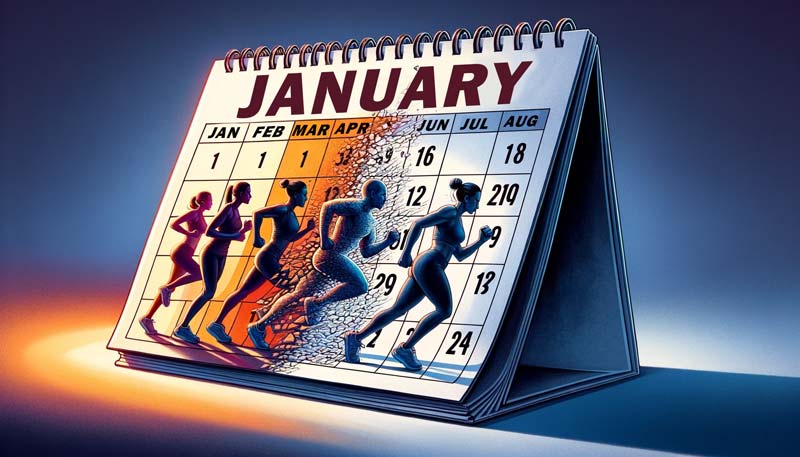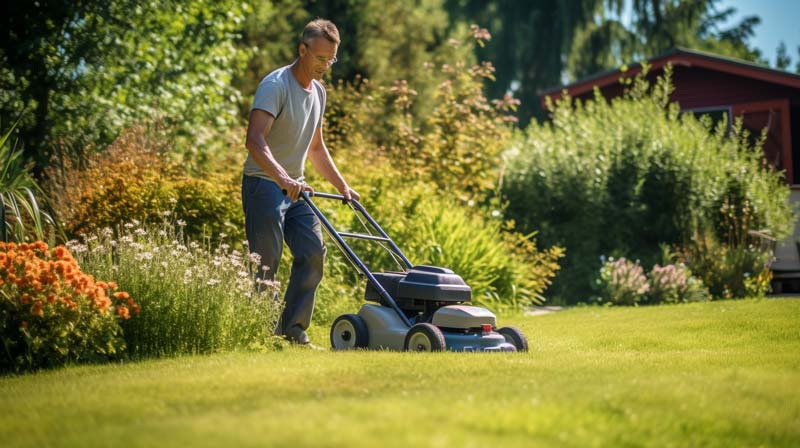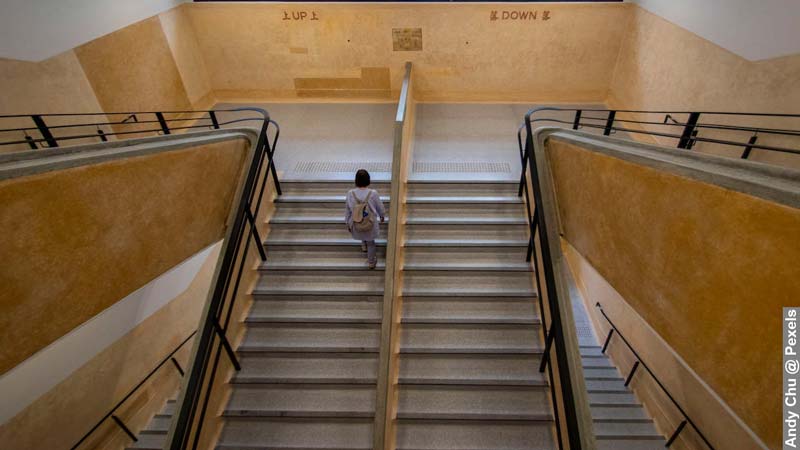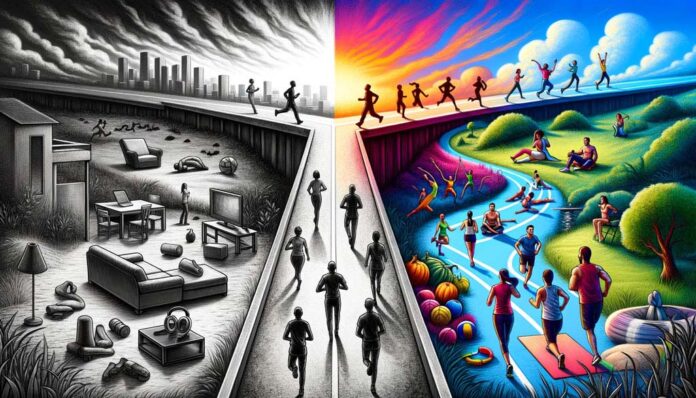Overcoming physical activity barriers is a joint New Year’s resolution for many of us, aiming for better health and fitness. But let’s face it, how often do these resolutions really stick? It’s not just a January thing; it’s a lifelong journey.
This year, instead of the typical cycle of enthusiastic start and gradual fade, let’s address the real reasons behind our struggle to stay active. Overcoming these barriers involves understanding the environmental and personal challenges, which is the first step.
In this article, we’ll break down these barriers and, more importantly, share ways to conquer them. From environmental to personal obstacles, we’ve got practical, achievable strategies for you. This isn’t about temporary fixes; it’s about changes that last all year and beyond.
So, you’re ready to move past the new year hype and into a lifestyle of genuine, sustainable activity. In that case, you’re in the right place. Let’s get started on this journey together.
The Myth of New Year’s Resolutions
It’s clear that setting New Year’s resolutions is a common practice, but how effective are they really? Let’s explore why these resolutions often fall short, especially around physical activity.
Key findings from a study revealed that while 77% of participants kept their resolutions for a week, only 19% succeeded for two years. This indicates a significant commitment drop over time despite initial enthusiasm. Such data challenges our understanding of resolution success and the factors influencing it.
Resolutions often fail, particularly those around fitness. Other studies show a significant drop-off in resolution commitment, decreasing from 8.7% to 13.0% in just eight weeks. Despite high initial commitment, the actual stickability is far lower.
Interestingly, while flexible goal adjustment is linked to better well-being, it doesn’t guarantee overcoming physical activity barriers. Goal tenacity, or persistence, also shows no significant correlation with maintaining resolutions or well-being. This challenges the notion that sheer willpower is the key to resolution success.
What are the most popular resolutions? Diet (29.0%) and exercise (24.6%). Yet, only 55% of people consider themselves successful in maintaining resolutions after 12 months. Approach-oriented goals proved to be more successful than avoidance-oriented ones.
This insight underscores the need for realistic, adaptable goals and a lifestyle approach to health and fitness, not just a short-lived New Year resolution but a commitment to overcoming physical activity barriers.

Unpacking the Barriers to Physical Activity
Identifying the obstacles in maintaining regular exercise is crucial for anyone committed to overcoming physical activity barriers. These obstacles fall into two categories: environmental and personal, each presenting unique challenges.
1. Addressing Environmental Obstacles:
Let’s consider the environmental factors. City living often means limited access to green spaces or safe walking paths. How often have we found ourselves deterred by the hustle of urban life or the unavailability of suitable facilities?
Moreover, weather plays a significant role; intense heat or biting cold can easily discourage outdoor activities. There’s also the influence of community norms and societal expectations – sometimes, the most significant barrier is simply not feeling supported or encouraged in our pursuit of physical fitness.
2. Tackling Personal Hurdles:
On a personal level, time is a precious commodity. Juggling work, family, and social obligations often leaves exercise on the back burner. It’s about finding time and going the extra mile to make time.
Minor and severe health conditions can also limit our ability to engage in physical activities. But it’s not just physical – psychological factors such as motivation, self-esteem, and past experiences can either fuel or frustrate our efforts to stay active.
In dissecting these barriers, we gain deeper insights into the diverse factors that can impede our path to regular physical activity. The key is recognising these obstacles and finding ways to creatively navigate them, which is essential in overcoming physical activity barriers.

Effective Strategies for Overcoming Physical Activity Barriers
Engaging in regular physical activity is a vital aspect of maintaining a healthy lifestyle. However, overcoming physical activity barriers on this journey can be challenging.
Understanding these barriers is one step; developing effective strategies is quite another. It calls for a blend of practicality, creativity, and personal adaptation.
Addressing these barriers isn’t just about carving out more time or exerting sheer willpower. Instead, it’s about reshaping our approach to fitness and integrating it more seamlessly into our daily lives.
Consequently, this section explores various strategies that can help dismantle these barriers, making physical activity a more attainable and enjoyable part of our routine.
1. Integrating Physical Activity into Daily Routines:
- Consider brief, manageable workouts that can easily fit into your daily schedule.
- Embrace walking more: choose stairs over lifts, park further away, and use short breaks for quick strolls.
- Combine physical activity with daily tasks like cleaning, gardening, or even during TV time.
2. Managing Energy and Motivation:
- Exercise in the morning to boost energy levels and maintain daily vitality.
- Adjust intensity levels to conserve energy while reaping health benefits.
- Set realistic goals and use tracking tools to enhance motivation.
3. Addressing Inconvenience and Boredom:
- Find activities that blend with your lifestyle, like lunchtime workouts or active commuting.
- Rotate your workout routines to keep them fresh and engaging.
- Involve friends and family in physical activities for communal fun and accountability.
4. Knowledge, Self-Consciousness, and Injury Fears:
- Access online resources and beginner-friendly gym sessions to build confidence.
- Incorporate proper warm-up and cool-down routines to prevent injuries.
- Start with low-risk activities that match your fitness and skill level.
5. Financial Constraints and Facility Limitations:
- Use free outdoor spaces and home workouts with minimal equipment.
- Utilise community facilities like local parks and recreational centres.
- Get creative with household items for workout equipment.
6. Encouraging Community Spirit and Overcoming Social Barriers:
- Seek support from family, friends, and colleagues.
- Join groups or clubs that align with your fitness interests.
- Embrace diversity in fitness, including different genders, cultures, and ages.
We should implement these strategies and adapt them to our needs and circumstances. We make overcoming physical activity barriers possible and a sustainable part of our lifestyle. The following section will build on these strategies, guiding us towards long-term habit formation for consistent physical activity.

Fostering Sustainable Physical Activity Habits
The World Health Organisation underscores the profound impact of physical activity on health and well-being. It’s not merely about disease management; it’s crucial for enhancing mental health, cognitive function, and the healthy development of children and adults.
Alarmingly, one in four adults globally doesn’t meet the recommended activity levels, leading to significant health risks and preventable deaths. This situation calls for dedicated efforts to overcome barriers to physical activity.
In recognising these benefits, exploring and implementing effective strategies for overcoming physical activity barriers is imperative. This exploration is vital for individual health and societal well-being. Below are some practical and creative methods to facilitate an active lifestyle.
1. Incorporate Activity into Daily Life:
- Opt for walking more frequently: choose stairs over elevators, park further away, and use short breaks for quick walks.
- Exercise while watching TV: engage in sit-ups, push-ups, or jogging on the spot.
- Turn household chores into exercise opportunities, like gardening or cleaning.
2. Boost Energy and Motivation:
- Schedule morning exercises to kickstart the day with energy.
- Set realistic, enjoyable goals using tracking tools to monitor progress.
3. Embrace Flexibility and Creativity:
- Adapt routines to changing circumstances.
- Mix various types of activities to keep the routine interesting.
4. Overcome Inconvenience and Financial Constraints:
- Utilise free outdoor spaces and minimal-equipment home workouts.
- Get creative with household items for workout equipment.
5. Build Knowledge and Confidence:
- Access online resources and beginner-friendly gym sessions.
- Start with low-risk activities that match your fitness level.
6. Foster Community and Social Support:
- Engage with friends, family, and local groups for mutual motivation.
- Join clubs that align with your fitness interests.
Adapting these strategies to our individual needs and contexts makes overcoming physical activity barriers possible and a sustainable part of our lifestyle. Thus, fosters long-term habit formation and steers us towards consistent physical activity and holistic well-being.

Embracing Holistic Well-being by Overcoming Physical Activity Barriers
Recognising the strategies for overcoming physical activity barriers illuminates a sustainable path to health and fitness. It’s about transforming our daily routines and embedding physical activity into the fabric of everyday life.
This shift moves us from temporary, often unattainable New Year resolutions to a more realistic and long-term approach. The World Health Organisation’s findings on the benefits of physical activity reinforce the importance of this shift. Our focus shouldn’t be confined to short-term goals. Instead, it should encompass a broader perspective of lifelong health and well-being.
The strategies and insights discussed here provide practical avenues to integrate physical activity seamlessly into our lives, catering to diverse needs and situations. In overcoming these barriers, we open doors to physical benefits and mental and emotional health improvements.
The passage towards overcoming physical activity barriers is a continuous process that demands adaptability, creativity, and commitment. By adopting these strategies, we start on a path to holistic well-being. Marking a significant step in improving both personal health and societal well-being.
Sources
- Dickson JM, Hart A, Fox-Harding C, Huntley CD. Adaptive Goal Processes and Underlying Motives That Sustain Mental Well-being and New Year Exercise Resolutions. Int J Environ Res Public Health. 2023 Jan 4;20(2):901.
- Norcross JC, Vangarelli DJ. The resolution solution: longitudinal examination of New Year’s change attempts. J Subst Abuse. 1988-1989;1(2):127-34.
- Oscarsson M, Carlbring P, Andersson G, Rozental A. A large-scale experiment on New Year’s resolutions: Approach-oriented goals are more successful than avoidance-oriented goals. PLoS One. 2020 Dec 9;15(12):e0234097.
- World Health Organization (26 November 2020) “Physical Activity”, Website [Accessed 28 December 2023]



